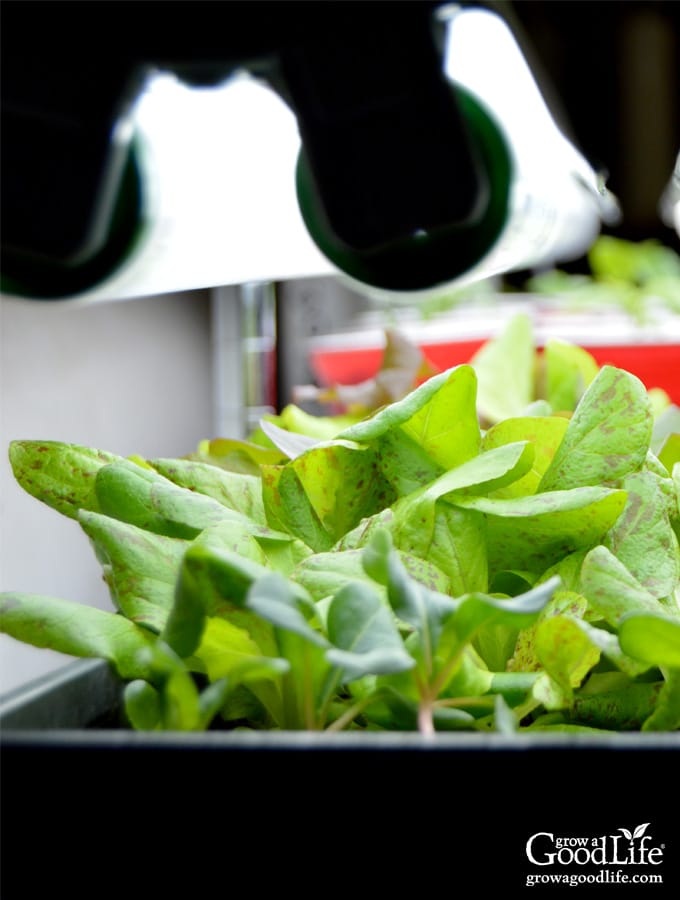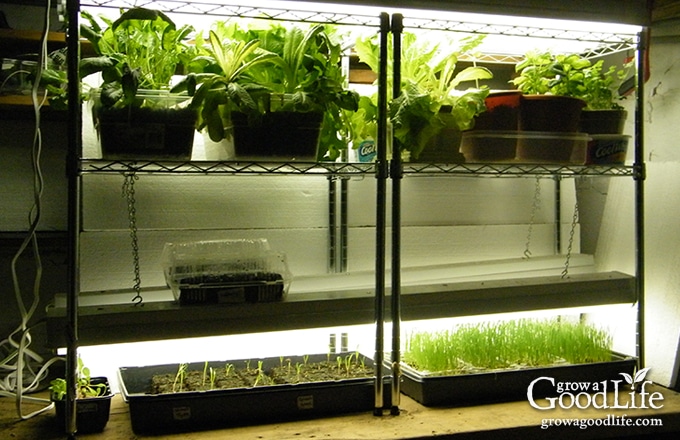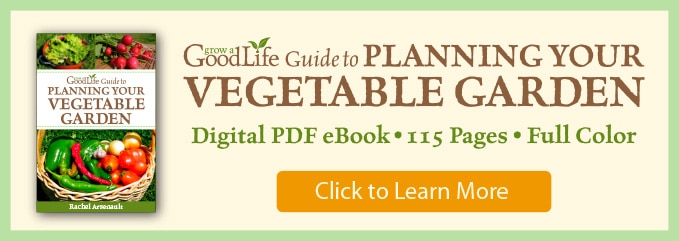Using Grow Lights for Seedlings and Indoor Gardens
This post may contain affiliate links, which means that I may receive a commission if you make a purchase using these links. As an Amazon Associate I earn from qualifying purchases.
Do you want to start garden seedlings indoors? You can grow healthy seedlings and plants indoors, with some supplemental light. Learn about using grow lights, plus tips to make an inexpensive grow light shelving unit.

Growing plants indoors is an enjoyable project for any gardener. Whether you want to start your garden seedlings, grow herbs inside, cultivate an indoor vegetable garden, or provide supplemental light to your houseplants during winter, using grow lights will help you raise healthy plants.
What is a Grow Light?
A grow light is an electric light that simulates natural sunlight. Plants need light for photosynthesis, which is the process of converting light, oxygen, and water into energy that helps the plant grow. In order to grow healthy seedlings and plants indoors, you will need some supplemental light. Using grow lights will provide
Natural sunlight contains all the color in the spectrum from red to blue, and yellow to violet. Grow lights are used to create an artificial light that closely replicates natural sunlight.
Commercial growers and greenhouse gardeners have additional lighting options, but for home growers, fluorescent or LED grow lights are all you need for starting seeds, and growing edibles indoors.
- Fluorescent Lights are budget friendly and ideal for germinating seeds, growing herbs, and leafy greens indoors. Fluorescent lights are not very expensive to use, don’t heat up, and are available in many sizes to fit your shelving. You can use full-spectrum bulbs, or a mix of cool and warm bulbs in order to recreate the full spectrum of light.
- LED Lights (Light Emitting Diod) offer full-spectrum lighting ideal for growing seedlings and plants indoors. They cost a bit more than fluorescent lights, but last longer, use less electricity, and provide better light spectrum than fluorescent bulbs. The pricing on LED lights has come down significantly over the years.
Benefits of Using Grow Lights for Seedlings
Get a jumpstart on your vegetable garden by growing your own transplants from seeds. Seedlings need more light than a windowsill can provide to grow healthy and strong. When they are not given enough bright light, the plants will grow weak and leggy. Using grow lights to start seeds is a great way to grow healthy transplants for your vegetable garden.
Starting your own vegetables, herbs, and flowers from seeds indoors under grow lights offers a number of benefits, including:
- It is less expensive than purchasing garden transplants.
- There is a greater selection of seeds available in comparison to the standard plant varieties at most local nurseries.
- You have full control over the quality of the plants. When you grow your own transplants, you know that they are well cared for and raised without unwanted chemicals.
- It provides a little gardening therapy during the winter months when the ground is under a layer of snow.
Using Grow Lights for Indoor Herb Gardens
Culinary herbs can be grown indoors on a sunny windowsill, but more light will help grow healthy dense foliage. Grow lamps can provide enough light so you can grow herbs that flourish inside even in winter. The article below provides information on how to start an indoor herb garden, plus which thrive inside:
Growing Vegetables Indoors with Lights
In addition to starting seedlings and herbs, artificial lights can also be used to grow many vegetables indoors. Most leafy greens and some root vegetables will grow very well inside under lights. Freshly harvested lettuce, spinach, and radishes are a treat in the middle of winter. The article below will help you get you started with your indoor vegetable garden:
How to Build a Grow Light Shelving Stand
When I first searched online for grow light shelving units for starting seeds indoors, I quickly discovered that they cost way more than I wanted to spend. A three-shelf unit with lights was well over $400 at the time (and around $600 as of 2022!). If you have the money to splurge on a grow light system, this 3-Tier Garden Grow Light Kit from Gardener Supply is a dream.
I could not afford such a unit, so this required some creative thinking to figure out a less-expensive option for starting seeds indoors. After shopping around, and learning my options, I built a grow light shelving unit in our basement using sturdy wire shelving, shop lights with florescent bulbs, a power strip timer, and seedling trays. I have used it for over 10 years now!
Parts for Your DIY Grow Lights
You can assemble your own inexpensive grow light shelving stand that will serve well for starting seeds indoors and growing an indoor garden. This is a simple and affordable grow light shelf made from easy to find equipment. Here is what you will need:
Wire Shelving
Look for a wire-shelving unit that accommodates 4-foot strip lights. I wasn’t able to find a large shelving unit locally, but I did find some 23-inch 3-tier shelving units. Two of these units placed side by side are the perfect size to hang two 4-foot shop lights across each shelf. The shelves are 13-inches deep and two standard seedling trays fit perfectly on each shelf. Plus there is room for two lamp fixtures on each shelf if more light is needed.
These 3-Tier Shelving Units can be found in big box stores or online. Be sure to select units that measure around 30 inches H x 23 inches W x 13 inches D.
If you want a larger grow light shelf, this 6-Tier Shelving Unit will more than double your growing space.
Lighting Fixtures
Fluorescent and LED lights come in all different shapes and sizes. You are looking for fixtures that will fit your shelves. If your shelves are 48-inches wide, then look for 4-foot fixtures that will distribute light evenly across the shelf.
Fluorescent Lights:
The lights I use are your standard 40-Watt 4-foot shop light fixtures found in big box stores or online for around $30. These come with chains and a couple s-hooks. You will need to pick up extra s-hooks to hook the chain to the wire shelving.
Fluorescent Bulbs:
Check the packaging of your lights to be sure you are buying the correct bulbs to fit your fixtures. The lights come in different sizes, including T8 and T5. The “T” in T5 stands for the bulbs is tubular shape, while the “5” denotes that it is five eighths of an inch in diameter. Older shop light fixtures that you may have around your basement or garage are T12. It may be difficult to find T12 bulbs.
Fluorescent light bulbs also come in full-spectrum, cool, or warm colors. Full-spectrum bulbs provide a balance of cool and warm lighting that represents natural lighting from the sun. Full spectrum lighting is the best for growing plants.
However, you can also mix and match a cool and warm bulb for a wider spectrum artificial light. Just be sure to rotate your trays every few days so your plants receive the benefits of both as they grow.
Cool white bulbs provide blue-green spectrum and are suitable for starting seeds, growing leafy greens, and herbs. The blue light stimulates vegetative growth of foliage and roots. Warm white bulbs provide red-orange spectrum that stimulates the production of blossoms and fruit. Red light helps regulate plant growth and development, and enhances photosynthesis. You can get a good balance of spectrum by combining one cool white and one warm white bulb in your light fixture.
If the bulb temperature isn’t shown on the box, look for the kelvin rating. Kelvin is often used as a measure of the color temperature of light sources. Full-spectrum lamps will have a kelvin rating of 5000 to 6500K. Cool bulbs are around 4000K, while warm bulbs are 3000K.
LED Grow Lights:
The newer LED grow lights offer full spectrum lighting ideal for growing seedlings and plants indoors. They are more expensive than fluorescent lights, but the pricing on LED lights has come down significantly over the years. Be sure to select the correct sizes for your shelving unit.
Power Strip with Timer
Seedlings require at least 12-16 hours of light each day. I set my power strip timer for 16 hours on, then 8 hours off. The power strip with a timer is also commonly available in big box stores or online.
Plastic Gardening Trays
You will need trays or containers to help prevent water from dripping. These black growing trays measure about 20 x 10 inches and one tray fits perfectly on each shelf. These trays are perfect for seed starting using cell packs or recycled containers. I like to double them up for a more secure tray that can be moved around without flexing. You can also use recycled produce trays or small plastic storage totes.
How to Setup Your Indoor Grow Light System:
This DIY indoor grow light system is a simple and affordable setup that is perfect for starting seeds for your vegetable garden, growing vegetables indoors, and providing light for your indoor herb garden. Here is how to put together a grow light shelf using easy to find items:
Step 1: Gather your Components
- 2 3-tier shelving units
- 4 4-foot shop lights plus bulbs if needed
- extra S-hooks
- power strip with a timer
- 4 Plant growing trays
Step 2: Assemble the Shelving Units
Follow the instruction that came with the shelving units and put them together. Since the shelves are adjustable, make sure they are at the same level for both units, and you have plenty of space for the plants and the light fixtures.
Step 3: Setup the Growing Area
Locate the shelves near an outlet. Try to select a place away from heavy traffic, pets, cold drafts, and excess heat. Place the shelving units side by side. I situated the shelves on a little used workbench, but they could also be raised up on a folding table to make it easy to tend to the seedlings.
Hang your lights from the top and middle shelves using the chains and s-hooks. Plug the lights into the power strip timer and plug the timer into the outlet.
Place your plastic gardening trays on the shelves, set your timer, and start growing seedling and edibles indoors. Keep the lights about 2-inches above the plants so you don’t burn the leaves, and adjust the level as the plants grow.
Watch your plants for signs of too much or not enough light, and adjust the lights as needed for the best light intensity. Plants that are receiving too much light will show signs yellowing of leaf burning, with scorched and bleached papery spots on the leaves.
Plants that are not getting enough light become leggy and tend to stretch towards the light source. Leggy plants have thin, weak stems and large gaps in between leaves. Other signals of not enough light include pale green, yellow, or white leaves. This is a clear sign that there is not enough light for the plant to produce chlorophyll. Plants without sufficient light may also drop their leaves, especially older leaves.

Step 4: Grow Something
Here are gardening and growing tips to get you started:
- Tips for Buying Seeds for Your Vegetable Garden
- How to Start Seeds Indoors
- Troubleshooting Seed Starting Issues
- 7 Herbs to Start from Seed
- 10 Reasons to Grow a Vegetable Garden
—
I hope I have encouraged you to put together your own inexpensive grow light system that will serve well for starting seeds indoors. It is also fun to experiment with growing edibles indoors during the winter months. Check out the following articles for tips for indoor gardening:
Good planning is key to a successful vegetable garden
Whether you are new to growing your own food or have been growing a vegetable garden for years, you will benefit from some planning each year. You will find everything you need to organize and plan your vegetable garden in my PDF eBook, Grow a Good Life Guide to Planning Your Vegetable Garden.


How many watts are needed for the fluorescent tubes?
Mine are 40 watts.
I use to have a tanning salon and have extra bulbs. I have been using them as grow lights and they at working fine. Is this ok?
If they are working, than sure, it’ ok.
Do you have any idea the ‘cost increase’ in electricity to run these lights for 16 hours? Thanks for any help.
Ellen, Sorry, no I do not. However, I am sure the cost of the electricity for the lights outweighs the cost of purchasing organic produce in the grocery store.
I would love to be able to print a copy of this article so I can have the instructions at hand to build one of these. It seems all methods of printing the info is disabled on this website. What a shame. I was going to subscribe but it will be an exercise if frustration if I can’t print ideas for my gardening notebook.
Beth, All you have to do is hit print on your browser and you can print the page. No special print button is needed.
I love this idea! I am wondering what the effect to my electric bill would be. Did you notice a jump in your electric bill from having these lights on most of the day?
Amanda, I do not notice a large spike in my electric bill when using these. In any case, the cost of growing seedlings instead of purchasing transplants will balance that out.
Great site. Can this grow system be set up in a basement with little natural light?
Lee, You will need more than just natural light to grow healthy plants.
Hi, Cool site. Thanks. What kind of soil do you need to use?
It depends on what you are growing. If you are starting seeds, use seedling mix as explained in step 3 of this article: https://growagoodlife.com/starting-seedlings-indoors/
If you are growing edibles, an all purpose potting mix will be fine: https://growagoodlife.com/indoor-garden/
Hello,
I saw your comment that this set-up will work for other edibles grown indoors, I’m curious about lettuces though. As a more cooler-weather plant, would you lessen the time needed for the lights to be on?
Thank you. Really enjoy your articles. Merry Christmas!
Joy, Thank you for your kind words. I grow lettuce indoors all winter and stick to the 16 hours on and 8 hours off lighting schedule without any problems. The florescent lights are not as strong as real sunlight and I believe the lettuce grows better with the longer lighting period. Lettuce also grows best in a cool location and will bolt or go to seed if your room is very warm.
Do you always keep that two-inch distance between the plants and the lights as they grow?
Eric, Yes, I try to keep the lights about 2-inches above the plants so they receive the maximum amount of light without touching the bulbs. I adjust the height with chains on s-hooks.
I wanted to say thank you! I built this last spring and grew perennials, annuals and all kinds of vegetables from seeds. I used regular shop lights with full spectrum bulbs (not grow lights) and it worked fine. I had it set up on a timer to go on and off. I am going to go bigger this year as I need more room for all the things I want to start from seed.
Amy, I am so happy that this was helpful for you. 🙂
Wonderful ideas here! I’m glad I found this website. I assumed I would have to buy “grow” lights but you are stating regular shop lights work fine, What exactly is the difference (besides price) between “grow” lights and shop lights? Again, thank you for a very informative site.
Marsha, I haven’t spent the money on grow lights so I can’t provide you a true comparison. Most grow lights claim to be more powerful and have a higher spectrum and wattage to provide the plants with more light. I do know from years of experience, that shop lights work fine to grow seedlings or other edibles indoors.